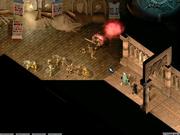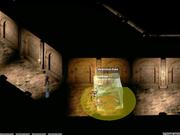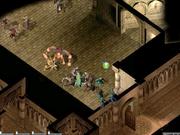Longtime fans of Dungeons & Dragons recall that The Temple of Elemental Evil, before it was a computer role-playing game, was a popular module for pen-and-paper D&D. In fact, the original version of The Temple of Elemental Evil is the quintessential D&D campaign. It puts a small party of adventurers, skilled in armed and magical combat, deep in a dangerous fortress filled with hundreds of sinister monsters and untold secrets and riches. The adventurers start off relatively weak, but through their trials and tribulations, they can become powerful enough to thwart the evil lurking in the temple's heart. To capture the spirit both of the original campaign and of modern-day pen-and-paper D&D, the developers implemented a turn-based combat system featuring the new 3.5 Edition D&D rules, which gives you a fine level of control over your party--as well as plenty of leisure time to admire the game's great-looking creatures. However, an occasionally cumbersome and obtuse interface and occasionally buggy gameplay do limit this game's appeal mostly to those who don't need an invitation or introduction to the world of Dungeons & Dragons. But these players should be readily willing to overlook the game's problems for the sake of its challenging, strategic battles.

The Temple of Elemental Evil is a single-player-only adventure with a straightforward premise that's mostly an excuse to put you through a lengthy, diverse dungeon crawl. This isn't an epic-scale adventure--most of the game takes place in the titular temple (though, at the beginning, you explore the countryside until you find it), though the temple is a sufficiently huge, multistory affair. Initially, you create a party of up to five characters (or you may choose from pregenerated characters), who begin as neophyte first-level adventurers and can eventually grow to 10th level, which isn't as high up there as some other recent D&D games have allowed you to get. Make no mistake, this is no flaw--Dungeons & Dragons is probably most well balanced, tense, and exciting at the earlier levels, so this game's focus on relatively low-level adventuring leads to many nail-biting battles in which you must take great care to keep your party out of harm's way as best you can. Indeed, starting out, your party is vulnerable even to common thugs, though later on, you'll start to feel quite powerful as your fighters gain multiple attacks per round, your healers become much more useful, and your mages learn to cast damaging area-of-effect spells.
One interesting aspect of The Temple of Elemental Evil is that the characters you can place in your party must be of similar moral alignment. In fact, you must choose a moral alignment for your party, which governs who can and can't be a part of it. For instance, a chaotic evil character wouldn't have any business being in a lawful good party, though a neutral good or lawful neutral character would be welcome. This choice affects the brief introductory sequence for your party (there are nine different variants, in total) as well as the conclusion of the game. Other than that, alignment doesn't play a huge role over the course of the game, as there isn't much in the way of dialogue with non-player characters--not compared to other D&D RPGs from over the past few years, anyway. Good, neutral, and evil characters alike will still find themselves fighting for their lives against the countless vicious foes defending the temple from any interlopers.

3rd Edition Dungeons & Dragons rules have been featured in computer games such as Pool of Radiance: Ruins of Myth Drannor, last year's Neverwinter Nights, and some others, but The Temple of Elemental Evil is the first game to use the 3.5 Edition rules. As the name implies, this update mostly adjusts the balance and some of the naming conventions of 3rd Edition D&D, and while some of the changes will seem very significant to hardcore fans, they aren't readily obvious, in general.
At any rate, the game clearly tries to stick as close to the book as possible, and purists will certainly appreciate this. The turn-based combat system faithfully incorporates most all the facets of pen-and-paper D&D. Not only that, but this is an interesting and complex game system in its own right, seemingly conceived with computer role-playing in mind. For example, each character moves in order of his or her initiative rating, and faster characters like monks and barbarians can move further in a round than others. Characters whose hit points are depleted in battle do not necessarily die outright (depending on how hard they were hit) but may find themselves at death's door--only if their wounds are tended to by an ally or if the battle is swiftly resolved will they be saved. Also, larger characters such as ogres, or characters with longer weapons such as spears, gain an attack of opportunity against incoming foes with smaller arms, discouraging their enemies from charging headlong into them. Characters may also use some unique tactical options, such as attempting to trip their foes, or trading their ability to move in one round for an additional attack. In all, these are just a few of the many complexities of the turn-based combat system of this game, which has plenty of strategic depth, making the relatively slow-paced combat anything but boring.
The game's interface does get in the way of the action to an extent, unfortunately. The mostly mouse-driven interface appears quite slick, but it's rather sluggish and lacks some important details. The mouse cursor moves jerkily about the screen, which makes it difficult to navigate the radial menus and click on some of the small text required, say, for casting spells. And, in general, the game assumes too much familiarity with the Dungeons & Dragons source material. When choosing new feats, skills, or spells for a character, you'll find yourself scrolling through long, purely text-based lists of the available options. Descriptions of the various choices are sometimes helpful, and sometimes not, which may leave you wondering whether you're making the best choices you could be.

As a result, if you don't already know enough about post-3rd Edition D&D to know that "cleave" is an extremely useful feat for a fighter, or that any wizard worth his salt should learn "fireball" at his or her earliest opportunity, then The Temple of Elemental Evil will be very difficult or even bewildering as you slog through the character-building process. It would have been great if the game, like Neverwinter Nights, allowed you to automatically choose "recommended" features for a character upon leveling up or during character creation. An interactive tutorial, a comprehensive manual, and a text-driven in-game help system should collectively provide someone with all the information they need to play and enjoy the game, but The Temple of Elemental Evil is certainly skewed toward those who already know their way around a Dungeons & Dragons game.
These players will most quickly notice the bugs in the game, but they are also the least likely to be overly disappointed by them. The bugs here generally aren't showstoppers, and they simply mean that certain skills, spells, or items won't work as you'd probably expect them to. But some--such as how monsters encountered while resting may spawn inside solid walls--are pretty annoying. In addition, the game has some AI problems. Pathfinding issues occasionally cause your party to become split up, especially in the temple's tight corridors, which can be really bad if just a couple of your characters blunder into an encounter. Also, some enemies will occasionally ignore your party members as you walk right into their midst, killing off some of their companions. And, in general, the game just seems rough around the edges, mostly on account of the unwieldy interface, and in some other details such as how spells and arrows seem to fly forth from characters' heads rather than their hands. Most all these issues could be resolved by a patch or two, but their presence in the retail version still means most players' experiences with The Temple of Elemental Evil will hit a few snags.
Too bad about that, because The Temple of Elemental Evil otherwise looks really great. Using a combination of fully 3D, texture-mapped character models and richly detailed prerendered background art, the game's look really comes alive and makes this one of the most visually impressive computerized Dungeons & Dragons experiences to date. The various monsters in the game feature most all the D&D classics like goblins, gnolls, bugbears, trolls, gelatinous cubes, hill giants, lizardmen, and more, as well as some more-esoteric critters like giant crayfish, giant toads, and others. These are faithfully based on the source fiction, yet they have real character and personality in their lifelike, highly articulated movements. Simply put, the character graphics in The Temple of Elemental Evil really help the game's cause. Even your own party of adventurers looks great, thanks to their realistically rippling capes and robes. Some generous spurts of blood and some impressive spell effects further add to the game's sharp look, though all this can be resource-intensive for slower systems. You'll notice how the game's larger battles noticeably impact your system's ability to render everything that's going on, and you may need to tone down some graphical options to get the game running smoothly.

The game's audio is very good, as well. An ambient musical score makes ample use of bass riffs and percussion, eschewing the typical symphonic soundtracks found in virtually all RPGs for a sound that's much more interesting. The only problem with the music is that there really isn't enough of it, and you'll hear the same combat themes, as good as they are, repeat frequently. Other than that, the voice work in the game isn't plentiful but is mostly good, and the actual sound effects of battle--monster groans, swords slicing their targets, the clack of crossbows firing, and so forth--are very well done.
Despite its bugs, The Temple of Elemental Evil stands as one of the most authentic PC Dungeons & Dragons experiences of the past few years. Rather than try to deliver some sort of epic, original storyline, the developers paid homage to a classic D&D campaign by faithfully capturing its settings and its challenges in a computer RPG. The result is a hack-and-slash game that's made entertaining by its complex combat system and great graphics and that suitably rewards your efforts as you survive numerous, difficult encounters to find your characters becoming much stronger. It's too bad that the game is rather rough around the edges, as issues with the interface and gameplay can occasionally undermine the fun. Then again, The Temple of Elemental Evil has some decent replay value, for good measure, due to its different intros and endings and to the overall depth of the highly refined game system that the developers managed to translate from the printed D&D rulebooks to a very good computer game.